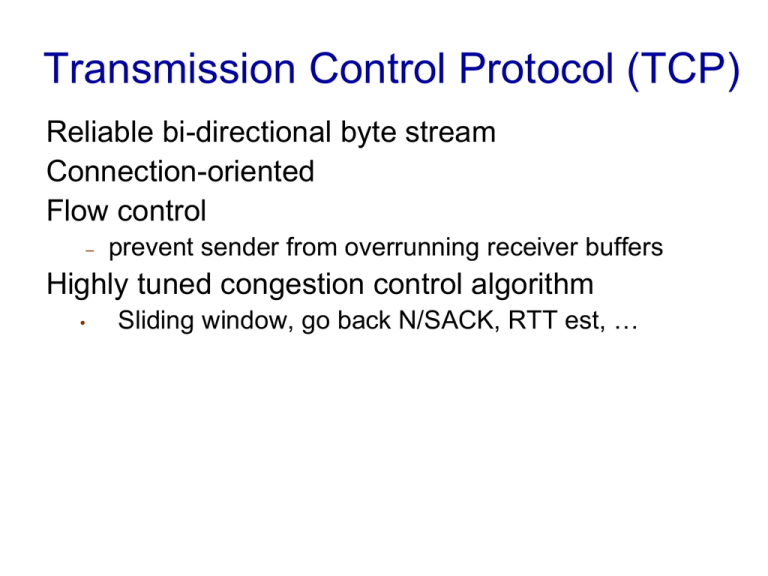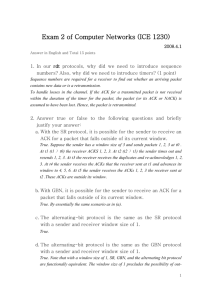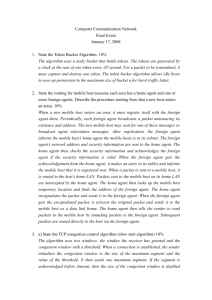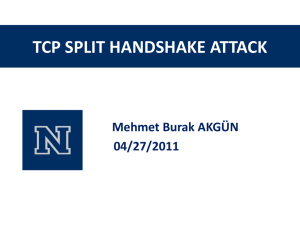TCP
advertisement

Transmission Control Protocol (TCP) Reliable bi-directional byte stream Connection-oriented Flow control − prevent sender from overrunning receiver buffers Highly tuned congestion control algorithm • Sliding window, go back N/SACK, RTT est, … Outline • Reliability • • • • • Connections Sliding Window • • • Retransmissions Sequence numbers Timeouts/RTTs Multiple in-flight messages Flow control Congestion Control 2 Reliable Transmission How do we send packets reliably? Two mechanisms − − Acknowledgements Timeouts Simplest reliable protocol: Stop and Wait Reliability: Stop and Wait Send a packet, wait until ack arrives retransmit if no ack within timeout Receiver acks each packet as it arrives Time Timeout Sender Receiver Reliability: Recovering from error Timeout Timeout Timeout Use a unique sequence number to recognize resends! Packet lost Timeout Timeout Timeout Time ACK lost Early timeout Success Reliability: What happens on reboot? How do we distinguish packets sent before and after reboot? Solutions? − − − − − Restart sequence # at 0? Remember last sequence number? Include epoch number in packet (stored on disk)? Ask other side what the last sequence # was? TCP sidesteps this problem with random initial seq # (in each direction) Reliability: Handling resends Use unique ID for each pkt − for both packets and acks Timeout Start from a random initial sequence number Reliability: How do we determine timeouts? If timeout too small, useless retransmits − − − can lead to congestion collapse (and did in 86) as load increases, longer delays, more timeouts, more retransmissions, more load, longer delays, more timeouts … Dynamic instability! If timeout too big, inefficient − wait too long to send missing packet Timeout should be based on actual round trip time (RTT) − varies with destination subnet, routing changes, congestion, … Reliability: Estimating RTTs Idea: Adapt based on recent past measurements − − − − − For each packet, note time sent and time ack received Compute RTT samples and average recent samples for timeout EstimatedRTT = 0.9*EstimatedRTT + 0.1*SampleRTT This is an exponentially-weighted moving average (low pass filter) that smoothes the samples. Set timeout to small multiple (2) of the estimate Reliability: Estimated Retransmit Timer Reliability: What about retransmissions? How do we distinguish first ack from retransmitted ack? − First send to first ack? • What if ack dropped? − Last send to last ack? • What if last ack dropped? Might never be able to fix too short a timeout! Timeout! Reliability: Retransmission ambiguity TCP: Karn-Partridge − − ignore RTT estimates for retransmitted pkts double timeout on every retransmission Add sequence #’s to retransmissions (retry #1, retry #2, …) Modern TCP (RFC 1323): Add timestamp into packet header; ack returns timestamp Reliability: Jacobson/Karels Algorithm Problem: − − Variance in RTTs gets large as network gets loaded Average RTT isn’t a good predictor when we need it most Solution: Track variance too. − − − − − Difference = SampleRTT – EstimatedRTT EstimatedRTT = EstimatedRTT + ( x Difference) Deviation = Deviation + (|Difference|- Deviation) Timeout = x EstimatedRTT + x Deviation In practice, = 1/8, = 1 and = 4 Reliability: Estimate with Mean + Variance Outline Time Sender Receiver Timeout What we have: What’s next: Example: BW = 1Mbps RTT = 100ms 10pks/sec • 10Mbps? Let’s send send multiple packets without waiting for first to be acked Outline • Reliability • • • • • Connections Sliding Window • • • Retransmissions Sequence numbers Timeouts/RTTs Multiple in-flight messages Flow control Congestion Control 16 Connections: What are they good for? Allows both sides to − − allocate state for buffer size, state variables, … calculate estimated RTT, estimated MTU, etc. Helps prevent − − Duplicates across incarnations Intentional hijacking • random nonces => weak form of authentication Connections: Three-Way Handshake Opens both directions for transfer Active participant (client) Passive participant (server) +data Connections: State Transitions Notation: send/receive CLOSED Active open /SYN Passive open Close Close LISTEN SYN/SYN + ACK Send/ SYN SYN/SYN + ACK SYN_RCVD ACK Close /FIN SYN_SENT SYN + ACK/ACK ESTABLISHED Close /FIN FIN/ACK FIN_WAIT_1 CLOSE_WAIT FIN/ACK ACK Close /FIN FIN_WAIT_2 FIN/ACK CLOSING LAST_ACK ACK Timeout after two ACK segment lifetimes TIME_WAIT CLOSED Connections: Teardown Symmetric: either side can close connection (or RST!) Web server Web browser Half-open connection; data can be continue to be sent Can reclaim connection after 2 MSL Can reclaim connection right away (must be at least 1MSL after first FIN) Connections: Why wait for 2MSL? We wait 2MSL (two times the maximum segment lifetime of 60 seconds) before completing the close Why? ACK might have been lost and so FIN will be resent Could interfere with a subsequent connection Connections: TCP Handshake in an Uncooperative Internet TCP SYN flood − − − Malicious attacker server maintains state for every open connection if attacker spoofs source addresses, can cause server to open lots of connections eventually, server runs out of memory Server Connections: TCP SYN cookies Solution: SYN cookies − − − Client Server keeps no state in response to SYN; instead makes client store state Server picks return seq # y = © that encrypts x Gets © +1 from sender; unpacks to yield x Server Outline • Reliability • • • • • Connections Sliding Window • • • Retransmissions Sequence numbers Timeouts/RTTs Multiple in-flight messages Flow control Congestion Control 24 Stop and Wait is slow Example: BW = 1Mbps, RTT = 100ms 10pks/sec What about 10Mbps? Let’s send send multiple packets without waiting for first to be acked 25 Sliding Window: Reliable, ordered delivery Two constraints: − − Receiver can’t deliver packet to application until all prior packets have arrived Sender must prevent buffer overflow at receiver Solution: sliding window − − Allows W packets to be outstanding Advance when sender and receiver agree packets at beginning have been received Sliding Window: Sender Sender buffers up to W segments until they are acknowledged • • LFS=Last Frame Sent, LAR=Last Ack Received Sends while LFS – LAR <= W W=5 Unsent Acked Unacked LAR LFS 27 Sliding Window: Sender Transport accepts another segment of data from the Application… • Transport sends it (as LFS-LAR 5) W=5 Unsent Acked Unacked LAR LFS 28 Sliding Window: Sender Next higher ACK arrives from peer… • • Window advances, buffer is freed LFS - LAR 4 (can send one more) W=5 Unsent Acked Unacked LAR LFS 29 Sliding Window: Cumulative Ack Receiver keeps only a single packet buffer for the next segment • State variable, LAS = Last Ack Sent On receiver: • • If seq. number is LAS+1, accept and pass it to app, update LAS, send ACK Otherwise discard (as out of order) 30 Sliding Window: Selective Ack Receiver passes data to app in order, and buffers out-of-order segments to reduce retransmissions ACK conveys highest in-order segment, plus hints about out-of-order packets 31 Sliding Window: Retransmissions Cumulative Ack sender uses a single timer to detect losses • On timeout, resends buffered packets starting at LAR+1 Selective Ack sender uses a timer per unacked packet to detect losses • • On timeout for packets, resend it Hope to resend fewer packets 32 Sliding Window: Shortcut timeout If packets usually arrive in order, out of order delivery is (probably) a packet loss − − TCP Fast retransmit if sender gets acks that don’t advance LAR, resends missing packet Sliding Window: Receiver Consider receiver with W buffers • • LAS = Last Ack Sent App pulls in-order data from buffer with recv() call W=5 Finished LAS Out of range 34 Sliding Window: Receiver Suppose the next two segments arrive, but app does not call recv() W=5 Finished LAS Out of range 35 Sliding Window: Receiver Suppose the next two segments arrive, but app does not call recv() • LAS rises, but we can’t slide window! W=5 Out of range Finished Acked LAS 36 Sliding Window: Receiver If further segments arrive (even in order) we can fill the buffer • Must drop segments until app recvs! W=5 Out of range Finished Acked LAS 37 Sliding Window: Flow Control Avoid loss at receiver by telling sender the available buffer space • • WIN=#Free, not W (from LAS) In TCP, WIN is measured in bytes WIN=3 Out of range Finished Acked LAS 38 Sliding Window: Flow Control Sender uses the lower of the sliding window and flow control window (WIN) as the effective window size WIN=3 Out of range Finished Acked LAS 39 Sliding Window: When to resume sending? If receive window = 0, sender stops − no data => no acks => no window updates Sender periodically pings receiver with one byte packet − receiver acks with current window size Sliding Window: Very slow senders/receivers What happens when the sender/receiver can only handle a few bytes at a time? − Silly window syndrome • receive window opens a few bytes • sender transmits little packet • receive window closes Solution (Clark, 1982): sender doesn’t resume sending until window is half open Outline • Reliability • • • • • Connections Sliding Window • • • Retransmissions Sequence numbers Timeouts/RTTs Multiple in-flight messages Flow control Congestion Control 42 Importance of Congestion Control TCP originally did not have congestion control Congestion control dynamically varies the size of the window to match available bandwidth − Sliding window uses minimum of cwnd, the congestion window, and the advertised flow control window The big question: how do we decide what size the window should be? Bandwidth Allocation Efficient: − Most capacity used but there is no congestion Fairness: − different users should get their fair share of the bandwidth Efficiency 50ms Router 1.5-Mbps DSL link Destination Packets dropped here Buffer absorbs bursts when input rate > output If sending rate is persistently > drain rate, queue builds Dropped packets represent wasted work Window size = round trip delay * bit rate Fairness vs Efficiency • If we care about fairness: • • • AB: ½, BC: ½, and AC: ½ Total traffic carried is 1 ½ If we care about efficiency: • • AB: 1, BC:1, and AC: 0 Total traffic rises to 2! A 1 B 1 C Fairness First, need to define what is a fair allocation. − Consider n flows, each wants a fraction fi of the bandwidth Max-min fairness: − First satisfy all flows evenly up to the lowest fi.. Repeat with the remaining bandwidth. f f 1 f f 2 3 4 Tracking the Bottleneck Bandwidth Additive increase − Ack arrives => no drop => increase window size by one packet/window • and therefore increase sending rate a little Multiplicative decrease − Timeout => dropped packet => cut window size in half • and therefore cut sending rate in half TCP “Sawtooth” Oscillates around bottleneck bandwidth − adjusts to changes in competing traffic What if two TCPs share link? Reach equilibrium independent of initial bw − assuming equal RTTs, “fair” drops at the router Why AIMD? Two users competing for bandwidth: Consider the sequence of moves from AIMD, AIAD, MIMD, MIAD. What if TCP and UDP share link? Independent of initial rates, UDP will get priority! TCP will take what’s left. Slow start How do we find bottleneck bandwidth? − Start by sending a single packet • start slow to avoid overwhelming network − Multiplicative increase until get packet loss • quickly find bottleneck − Remember previous max window size • shift into linear increase/multiplicative decrease when get close to previous max ~ bottleneck rate • called “congestion avoidance” Slow Start Quickly find the bottleneck bandwidth Avoiding burstiness: ack pacing bottleneck packets Sender Receiver acks Window size = round trip delay * bit rate Putting It All Together Timeouts dominate performance! Fast Retransmit 1 Can we detect packet loss without a timeout? − Receiver will reply to each packet with an ack for last byte received in order Duplicate acks imply either − − packet reordering (route change) packet loss 3 5 2 4 1 1 1 2 TCP Tahoe − resend if sender gets three duplicate acks, without waiting for timeout 1 5 1 Fast Retransmit Caveats Assumes in order packet delivery − Recent proposal: measure rate of out of order delivery; dynamically adjust number of dup acks needed for retransmit Doesn’t work with small windows (e.g. modems) − what if window size <= 3 Doesn’t work if many packets are lost − example: at peak of slow start, might lose many packets Fast Retransmit Slow Start + Congestion Avoidance + Fast Retransmit 18 16 14 12 window 10 (in segs) 8 6 4 2 0 0 1 2 3 4 5 6 7 8 9 10 11 12 13 14 15 16 17 18 19 20 21 22 23 24 25 26 27 28 round-trip times Fast Recovery When doing fast retransmit, don’t use slow start Instead, go straight to congestion avoidance Fast Recovery Slow Start + Congestion Avoidance + Fast Retransmit + Fast Recovery 18 16 14 12 window 10 (in segs) 8 6 4 2 0 0 1 2 3 4 5 6 7 8 9 10 11 12 13 14 15 16 17 18 19 20 21 22 23 24 25 round-trip times TCP: This is your life... 1984 1975 Three-way handshake Raymond Tomlinson In SIGCOMM 75 1974 TCP described by Vint Cerf and Bob Kahn In IEEE Trans Comm 1975 Nagel’s algorithm 1987 to reduce overhead Karn’s algorithm 4.3BSD Reno to better estimate of small packets; round-trip time fast retransmit 1983 predicts congestion 1986 1988 delayed ACK’s BSD Unix 4.2collapse Van Jacobson’s Congestion supports TCP/IP algorithms collapse 1982 congestion avoidance observed and congestion control TCP & IP RFC 793 & 791 1980 1990 (most implemented in 4.3BSD Tahoe) 1985 1990 TCP: After 1990 1994 1996 T/TCP SACK TCP (Braden) (Floyd et al) Transaction Selective 1996Acknowledgement1996 TCP 1993 1994 TCP Vegas ECN Hoe FACK TCP (Brakmo et al) (Floyd) (Mathis et al) real congestion avoidance Explicit Improving TCP startup Congestion Notification 1993 1994 1996 extension to SACK 2006 SPDY Slow Start Problems Bursty traffic source − − will fill up router queues, causing losses for other flows solution: ack pacing Slow start usually overshoots bottleneck − − will lose many packets in window solution: remember previous threshold Short flows − − Can spend entire time in slow start! solution: persistent connections? What if TCP connection is short? Slow start dominates performance − − What if network is unloaded? Burstiness causes extra drops Packet losses unreliable indicator − − − can lose connection setup packet can get drop when connection near done signal unrelated to sending rate In limit, have to signal every connection − 50% loss rate as increase # of connections







